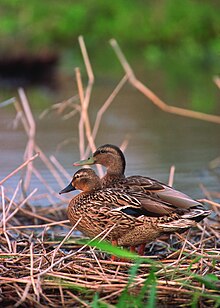Hawaiian duck
| Hawaiian duck | |
|---|---|
 |
|
| Scientific classification | |
| Kingdom: | Animalia |
| Phylum: | Chordata |
| Class: | Aves |
| Order: | Anseriformes |
| Family: | Anatidae |
| Subfamily: | Anatinae |
| Genus: | Anas |
| Species: | A. wyvilliana |
| Binomial name | |
|
Anas wyvilliana Sclater, 1878 |
|
The Hawaiian duck (Anas wyvilliana) or koloa is a species of bird in the family Anatidae that is endemic to the large islands of Hawaiʻi. Taxonomically, the koloa is closely allied with the mallard (A. platyrhynchos),. It differs in that it is monochromatic (with similarly marked males and females) and non-migratory. As with many duck species in the genus Anas, Hawaiian duck and mallards can interbreed and produce viable offspring, and the koloa has previously been considered an island subspecies of the mallard. However, all major authorities now consider this form to be a distinct species within the mallard complex. Recent analyses indicate that this is a distinct species that arose through ancient hybridization between mallard and Laysan duck (Anas laysanensis). The native Hawaiian name for this duck is koloa maoli (meaning "native duck"), or simply koloa. This species is listed as endangered by the IUCN Red List of Threatened Species, and its population trend is decreasing.
Both male and female are mottled brown in color and resemble a female mallard. The males are usually bigger than the females. The speculum feathers of both sexes are green to blue, bordered on both sides by white. The tail is dark overall, unlike the black-and-white tail of a mallard. The feet and legs are orange to yellow-orange. The bill is olive green in the male and dull orange with dark markings in the female. The adult male has a darker head and neck, which is also sometimes green. The female is generally lighter-colored than the male and has plainer back feathers. A first-year male Hawaiian duck looks like an eclipse-plumaged male mallard. Seasonal plumage differences, individual variation, and variation between islands can make it difficult to differentiate between Hawaiian ducks, female mallards and hybrids of Hawaiian ducks and mallards. In addition, the extent of hybridization at a location can contribute to the difficulty of identification.
The male Hawaiian duck has an average length of 48–50 cm (19–19.5 in) and the female has an average length of 40–43 cm (15.5–17 in). On average, the male weighs 604 grams (21.3 ounces) and the female weighs 460 grams (16 ounces). The Hawaiian duck is typically smaller than the mallard by 20 to 30 percent.
...
Wikipedia

